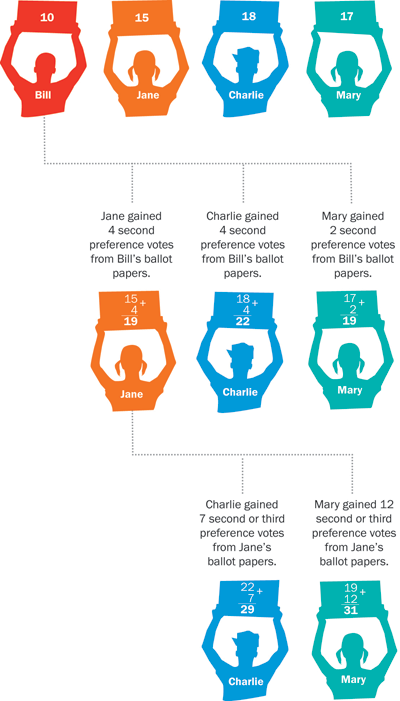Use a clear space, such as a large table, for sorting and counting ballot papers. Open the ballot box and empty it of all ballot papers. If the ballot box contains a mix of ballot papers for different elections, they will need to be separated first as each will have its own counting process.
Unfold and check that each ballot is 'formal' i.e. it can be counted. As a general rule a vote is formal when:
Count the total number of ballot papers and the number of formal and informal (votes that cannot be counted) votes. Record these on the Tally sheet – first-past-the-post. Put any informal votes to one side as they are no longer involved in the count.
Place a name card for each candidate on the table to assist with the count. Record the name of each candidate on the Tally sheet.

Sort the formal ballot papers into piles according to which candidate was chosen by each voter. Count the number of votes each candidate received and record this on the Tally sheet.
The candidate with the highest number of votes is elected.
If you have a tied result, decide the outcome in one of the following ways:
Use a clear space, such as a large table, for sorting and counting ballot papers. Open the ballot box and empty it of all ballot papers. If the ballot box contains a mix of ballot papers for different elections, they will need to be separated first as each will have its own counting process.
Unfold and check that each ballot is 'formal' i.e. it can be counted. As a general rule a vote is formal when:
Count the total number of ballot papers and the number of formal and informal (votes that cannot be counted) votes. Record these on the Tally sheet – preferential. Put any informal votes to one side as they are no longer involved in the count.
Place a name card for each candidate on the table to assist with the count. Record the name of each candidate on the Tally sheet.

First, sort all the formal ballot papers in candidate piles according to the voter's first preference (the number 1). Then, count the number of first preference votes for each candidate and record these totals in the 1st count column of the Tally sheet.
To be elected using the preferential voting system, a candidate must receive more than half of the votes (an absolute majority). If there are 100 votes, then to be elected a candidate must receive 51 votes – more than 50% of the votes.
The next step of the counting process is to take the candidate with the fewest votes out of the count (exclude) and re-examine those votes. If two candidates have equal lowest votes, exclude the candidate who had the lowest number of votes in the previous count.
The second choice (candidate with the number 2) is identified on each ballot and the vote is transferred to the second choice candidate.
Once all votes for the excluded candidate are redistributed to remaining candidates, record these additional votes in the transferred vote column of the Tally sheet. Now add these two columns to arrive at the 2nd count total.
If there still isn't an absolute majority for any candidate, repeat this exclusion process. The candidate with the fewest votes at this point is excluded and the votes for this candidate are redistributed to the voter's next choice candidate. This can be indicated by a number 2 or the number 3 depending on which candidates remain in the count.
This exclusion and re-distribution continues until a candidate has achieved the absolute majority i.e. more than 50% of all votes cast.
If you have a tied result, refer back to the candidates' first preference votes. The candidate who had the most first preference votes is elected. If the result is still tied (the final two candidates both had an equal number of first preferences), determine the outcome in one of the following ways:
Four candidates, Bill, Jane, Charlie and Mary stand for election. After the election, the ballot papers are counted and there are 60 formal votes. Therefore the absolute majority needed to win the seat is 31 (more than 50%).

Nobody has gained an absolute majority so the person with the lowest number of votes is excluded (Bill with 10 votes). Bill's votes are then distributed according to the 2nd preferences marked on those ballot papers.
Still nobody has gained the absolute majority so again the candidate with the lowest number of votes is excluded.
There are two candidates with equal least votes – Mary and Jane each with 19. In this situation the candidate who had the lowest number of votes in the first count is excluded (Jane) and those votes are distributed.
Now that Mary has 31 votes, she has an absolute majority and is elected.
You may notice that Mary was not the candidate who had the 'most' votes in the first count. This highlights the difference between preferential counting and first-past-the-post.
Read about the 5 steps here or download the resources to get the full package in print format.
1
Get
started
Planning and nomination
2
Get
organised
Pre-election preparation
3
Get
informed
Voter education & campaigns
4
Get
voting
Election day
5
Get
results
Counting & announcement